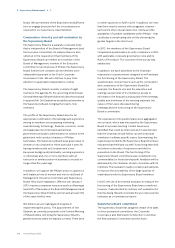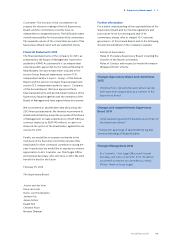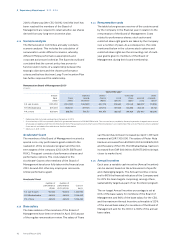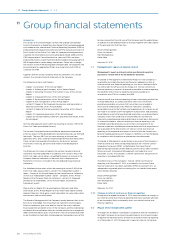Philips 2013 Annual Report Download - page 118
Download and view the complete annual report
Please find page 118 of the 2013 Philips annual report below. You can navigate through the pages in the report by either clicking on the pages listed below, or by using the keyword search tool below to find specific information within the annual report.10 Corporate governance 10 - 10.1
118 Annual Report 2013
10 Corporate governance
Corporate governance of the Philips group - Introduction
Koninklijke Philips N.V., a company organized under Dutch law (the
‘Company’), is the parent company of the Philips Group (‘Philips’ or the
‘Group’). The Company, which started as a limited partnership with the
name Philips & Co in Eindhoven, the Netherlands, in 1891, was converted
into the company with limited liability N.V. Philips’ Gloeilampenfabrieken
on September 11, 1912. The Company’s name was changed to Philips
Electronics N.V. on May 6, 1994, to Koninklijke Philips Electronics N.V. on
April 1, 1998, and to Koninklijke Philips N.V. on May 3, 2013. Its shares have
been listed on the Amsterdam Stock Exchange, Euronext Amsterdam,
since 1912. The shares have been traded in the United States since 1962
and have been listed on the New York Stock Exchange since 1987.
Over the last decades the Company has pursued a consistent policy to
improve its corporate governance in line with Dutch, US and international
(codes of) best practices. The Company has incorporated a fair disclosure
practice in its investor relations policy, has strengthened the
accountability of its executive management and its independent
supervisory directors, and has increased the rights and powers of
shareholders and the communication with investors. The Company is
required to comply with, inter alia, Dutch Corporate Governance rules, the
US Sarbanes-Oxley Act, other US securities laws and related regulations
(including applicable stock exchange rules), insofar as applicable to the
Company. A summary of significant dierences between the Company’s
corporate governance practice and the New York Stock Exchange
corporate governance standards is published on the Company’s website
(www.philips.com/investor).
In this report, the Company addresses its overall corporate governance
structure and states to what extent and how it applies the principles and
best practice provisions of the Dutch Corporate Governance Code (as
revised on December 10, 2008; the ‘Dutch Corporate Governance Code’).
This report also includes the information which the Company is required to
disclose pursuant to the Dutch governmental decree on Article 10
Takeover Directive and the governmental decree on Corporate
Governance. Deviations from aspects of the corporate governance
structure of the Company, when deemed necessary in the interests of the
Company, will be disclosed in the Annual Report. Substantial changes in
the Company’s corporate governance structure and in the Company’s
compliance with the Dutch Corporate Governance Code, if any, will be
submitted to the General Meeting of Shareholders for discussion under a
separate agenda item. The Supervisory Board and the Board of
Management, which are responsible for the corporate governance
structure of the Company, are of the opinion that the principles and best
practice provisions of the Dutch Corporate Governance Code that are
addressed to the Board of Management and the Supervisory Board,
interpreted and implemented in line with the best practices followed by
the Company, are being applied.
10.1 Board of Management
Introduction
The Board of Management is entrusted with the management of the
Company. Certain key officers have been appointed to manage the
Company together with the Board of Management. The members of the
Board of Management and these key officers together constitute the
Executive Committee (the ‘Executive Committee’). Under the
chairmanship of the President/Chief Executive Officer (‘CEO’) the
members of the Executive Committee share responsibility for the
deployment of its strategy and policies, and the achievement of its
objectives and results. The Executive Committee has, for practical
purposes, adopted a division of responsibilities indicating the functional
and business areas monitored and reviewed by the individual members.
For the purpose of this document, where the Executive Committee is
mentioned this also includes the Board of Management unless the context
requires otherwise.
The Board of Management remains accountable for the actions and
decisions of the Executive Committee and has ultimate responsibility for
the Company’s management and the external reporting and is answerable
to shareholders of the Company at the Annual General Meeting of
Shareholders.
All resolutions of the Executive Committee are adopted by majority vote
comprising the majority of the members of the Board of Management
present or represented, such majority comprising the vote of the CEO. The
Board of Management retains the authority to, at all times and in all
circumstances, adopt resolutions without the participation of the other
members of the Executive Committee. In discharging its duties, the
Executive Committee shall be guided by the interests of the Company and
its affiliated enterprise, taking into consideration the interests of the
Company’s stakeholders.
The Executive Committee is supervised by the Supervisory Board and
provides the latter with all information the Supervisory Board needs to
fulfill its own responsibilities. Major decisions of the Board of Management
and Executive Committee require the approval of the Supervisory Board;
these include decisions concerning (a) the operational and financial
objectives of the Company, (b) the strategy designed to achieve the
objectives, (c) if necessary, the parameters to be applied in relation to the
strategy and (d) corporate social responsibility issues that are relevant to
the Company.
The Executive Committee follows the Rules of Procedure of the Board of
Management and Executive Committee, which set forth procedures for
meetings, resolutions and minutes. These Rules of Procedure are
published on the Company’s website.
(Term of) Appointment and conflicts of interests
Members of the Board of Management as well as the CEO are appointed
by the General Meeting of Shareholders upon a binding recommendation
drawn up by the Supervisory Board after consultation with the CEO. This
binding recommendation may be overruled by a resolution of the General
Meeting of Shareholders adopted by a simple majority of the votes cast
and representing at least one-third of the issued share capital. If a simple
majority of the votes cast is in favor of the resolution to overrule the
binding recommendation, but such majority does not represent at least
one-third of the issued share capital, a new meeting may be convened at
which the resolution may be passed by a simple majority of the votes cast,
regardless of the portion of the issued share capital represented by such
majority. In the event a binding recommendation has been overruled, a
new binding recommendation shall be submitted to the General Meeting
of Shareholders. If such second binding recommendation has been
overruled, the General Meeting of Shareholders shall be free to appoint a
board member.
Members of the Board of Management and the CEO are appointed for a
term of four years, it being understood that this term expires at the end of
the General Meeting of Shareholders to be held in the fourth year after the
year of their appointment. Reappointment is possible for consecutive
terms of four years or, if applicable, until a later retirement date or other
contractual termination date in the fourth year, unless the General
Meeting of Shareholders resolves otherwise. Members may be suspended
by the Supervisory Board and the General Meeting of Shareholders and
dismissed by the latter. Individual data on the members of the Board of
Management and Executive Committee are published in chapter 7,
Management, of this Annual Report.
The other members of the Executive Committee are appointed,
suspended and dismissed by the CEO, subject to approval by the
Supervisory Board.
The acceptance by a member of the Board of Management of a position as
a member of a supervisory board or a position of non-executive director in
a one-tier board (a ‘Non-Executive Directorship’) at another company
requires the approval of the Supervisory Board. The Supervisory Board is
required to be notified of other important positions (to be) held by a
member of the Board of Management. Under the Dutch Corporate
Governance Code, no member of the Board of Management shall hold
more than two Non-Executive Directorships at listed companies, or is a
chairman of a supervisory board or one-tier board, other than of a Group
company or participating interest of the Company. New Dutch legislation,
eective January 1, 2013, provides for further limitations on the Non-
Executive Directorships. No member of the Board of Management shall
hold more than two Non-Executive Directorships at ‘large’ companies
(naamloze vennootschappen or besloten vennootschappen) or ‘large’
foundations (stichtingen) as defined under Dutch law and no member of
























